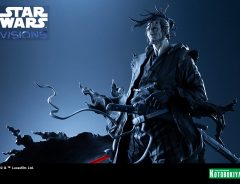- Tags:
- Buddha / Nanzo-in Temple / Reclining Buddha / Statue
Related Article
-

Show off your figures, statues & models with awesome rotating LED spotlight display cases
-

The mysterious RONIN from Star Wars: Visions takes stoic pose in striking Kotobukiya statue
-

Transformers Bishoujo statues from Kotobukiya: Optimus Prime and Megatron imagined as girls
-

This Full-Sized Unicorn Gundam Statue Is A Must-See Tokyo Attraction
-

Cat purrs its way to enlightenment in the hands of Tokyo’s Great Buddha
-

The challenge of cleaning Japan’s tallest statue; the Ushiku Daibutsu



Tucked away in the folds of the peaceful mountain town of Sasaguri, just north of the bustling city of Fukuoka, rests the Buddhist retreat of Nanzo-in temple where a bronze titan can be found jutting its head out of the foliage.
Nanzo-in Temple originally stood amongst the many Buddhist temples of Mount Koya, but after threats in 1886 from local anti-Buddhist groups, who sought to have the temple destroyed, it was moved to its current location of Sasaguri. The move was overseen by the head priest of Sasaguri, Hayashi Satoshiun, and the transfer was complete by 1899.
The temple sees an annual visit of around 1 million people, who come to the complex not only to pray and see the giant reclining buddha, but many also come to take part in the Sasaguri Pilgrimage. The pilgrimage, which takes 3 days and is 44 kilometers in length, is one of the three famous walking routes of Japan. Nanzo-in temple is both the starting point and the main location out of 88 shrines on the course. The temple is strongly associated with luck and winning the lottery, as throughout its history many have claimed to have had luck bestowed on them after laying their lottery ticket next to a statue of Daikoku, who is one of the seven lucky gods.
500 sculptures of the disciples of Buddha sit at the base of the giant statue. Each sculpture has a different posture and expression. | Photo by Connie Sceaphierde
The reclining buddha of Nanzo-in Temple
At 41 meters in length, 11 meters in height and weighing in at an astounding 300 tons, the bronze reclining buddha at Nanzo-in temple, known is Japanese as Nehanzo, is arguably the world’s largest bronze statue. Although not as old as it’s sister statues at Nara and Kamakura, it is certainly the heaviest, with the Nara statue weighing 250 tons and the statue of Kamakura just 93 tons.
The building of the giant structure is an important structure and is said to house some of the ashes of the Buddha and two of his attendants, Ananda and Maudgalyayana. The temple in north Fukuoka had been sending medical aid to the children of Nepal and Myanmar for many years, and to show their thanks, the Buddhist council of Myanmar gave Nanzo-in some of the Buddha’s ashes. The majority of statues of Buddha in Japan show the figure sitting or standing, with the least common pose being the reclining buddha. The more common sitting pose of buddha is said to show the buddha meditating, whilst the reclining buddha is believed to be a representation of the Buddha reaching Nirvana at the point of his death; a seemingly good fit for the building that houses the ashes of the Buddha.
Construction of the bronze statue at Nanzo-in was completed in 1995. The unveiling of the giant statue in 1995 was attended by 1,300 monks from Nepal and Myanmar, in addition those who follow the sect in Japan. Each year, there is a large cleaning event held at the temple, where 100s of buddhist monks come together to clean the statue with bamboo leaves on poles 5 meters in length. It is said that the costs of the statue fell to the head priest at the temple, who is apparent proof of the temple’s legendary luck as he had supposedly won the lottery multiple times.
To get to the reclining buddha, visitors must first walk through the Shichifukujin tunnel, which is dedicated to the seven lucky gods of Japan, and then climb up the steps to the opening where the statue is sprawled across. A long colourful ribbon is tied to the left hand of the statue, and it is believed that you can gain the knowledge of buddha by saying a prayer while grasping the ribbon. Holding the ribbon is said to represent holding the hand of buddha as he reaches Nirvana. Another common type of prayer made at the statue is to make a wish whilst rubbing the ornately decorated feet of the buddha. Here, the bronze colouring has been polished into a warm gold by the many hands that have stroked the feet of the statue over the years. At the base of the statue, there are 500 smaller statues of the disciples of buddha, each coming with a different facial expression and pose as well as 365 columns representing the days of the year.
Entering the temple grounds is free, however for a fee of 500 yen, visitors can receive a prayer stick to write on and entrance to the prayer room inside of the statue. Inside, there is a room to leave your prayer stick, as well as the main hallway where sand from each of the 88 temples of Shikoku Pilgrimage are contained beneath small golden statues of buddha.
You can say a prayer whilst rubbing the giant ornate feet of the buddha statue. | Photo by Connie Sceaphierde
How to get to Nanzo-in Temple
Nanzo-in temple is open 9am-5pm 365 days per year, and is a 5 minute walk from Kido Nanzo-in-mae station. To get to the station, take the JR Sasaguri line from Hakata Station in central Fukuoka. Local trains on the line take 24 minutes to reach Kido Nanzo-inmae station, whilst express trains take 21 minutes.